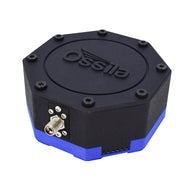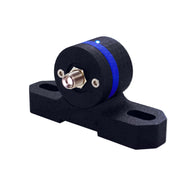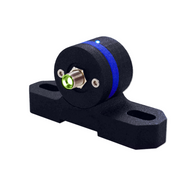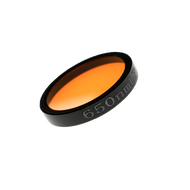Spectroscopy Equipment
Spectrometers are used to characterize thin film samples and solutions through optical spectroscopy.
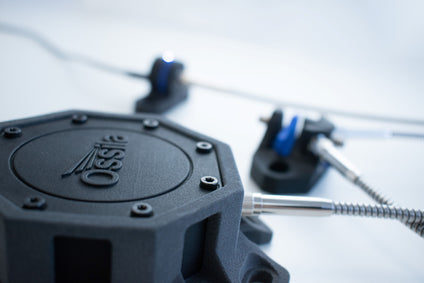
The Ossila USB Spectrometer is compact and cost-effective, integrating seamlessly into any lab set up. With user-friendly software, our spectrometers are designed for ease of use, making them accessible to as many researchers as possible. Whether your focus is absorption, reflectance, or photoluminescence, our spectrometers deliver reliable and accurate measurements.
The modular design and array of complementary accessories allows you to customize the system to meet your specific research needs. For a complete set up, our optical spectroscopy kit offers unmatched value. It includes everything you need to get started with your measurements, making it an ideal choice for both seasoned researchers and newcomers to the field.
Our low-price spectrometers have a small lab footprint and come with accompanying software to enable fast integration with any lab. Each spectrometer is equipped with free spectroscopy software and updates. Created to be powerful and simple to use, it eliminates the need for advanced programming skills, allowing you to focus on what really matters – your research.
Jump to: Browse spectrometers and accessories | Types of measurements | Resources and support
Browse Spectroscopy Equipment
Filter by product:
Taking Measurements with a Spectrometer
Our optical spectrometer has many potential applications that span multiple disciplines. It can be used for the characterization of LEDs and lasers, (anti)reflection coating efficiency measurements, for investigations into absorbing materials, fluorescence detection, photovoltaics, and much more.
Optical Absorption
The optical absorption of material will tell you about the wavelengths of light that it will absorb. With this information, along with emission data, you can probe the internal electronic and vibrational structure of atoms and molecules. In some cases, this can give you information about the conformational structure of molecules and polymers within your sample.
Absorbance measurements can also be used to calculate the concentration of absorbing species in a sample or monitor the progress of chemical reactions.
The ability to measure absorption is critical for applications such as chemical synthesis and analysis, material discovery (for photovoltaics, LEDs, or pharmaceuticals) and quality control.
Typically, the spectroscopy light source used for absorption and transmission measurements has a very broad spectrum. Suitable sources include deuterium or tungsten halogen lamps or an LED broadband white light source.
Transmission and Reflectivity
Transmission and reflectivity measurements have applications that range from characterising photonic structures such as dielectric stacks (often used as high-reflectivity or antireflection coatings) to process control in manufacturing. They can be used to detect changes in film thickness, density changes, and even the presence or absence of objects.
Light Scattering
Scattering measurements are much less common, due in part to the difficulties in predicting and detecting where the light will scatter. With the correct procedures, optical spectrometers can be used to calculate the size and distribution of scattering centers within a sample. They are also useful for impurity detection/monitoring in water systems, nanoparticle characterization and drug loading for pharmaceuticals.
Luminescence
Our spectrometer can also be used to measure the emission spectrum of materials and devices. Studying the light that is emitted by a material is a complementary technique to absorption spectroscopy, in that it probes how processes lead to the conversion of internal energy to photons, rather than the other way around.
The optical spectrometer can be used to measure various type of radiative emission measurements including steady-state photoluminescence, fluorescence and phosphorescence. In these cases, the compatible Ossila UV light source can be used as an excitation source. Alternatively, you can use a high energy laser of appropriate wavelength. You can also use the spectrometer to measure the emission of light from non-radiative excitation sources, such as for electroluminescence measurements.
From emission measurements, you can extract information about the electronic and vibrational states of a material, as well as how these materials are interacting with their surroundings. This information can be used to complement (or as an alternative to) absorption measurements for chemical synthesis and analysis, material characterisation and discovery, quality control, and more. In addition, luminescence also has some unique applications. For example, fluorescent molecules are often used as 'tags' or 'tracers' in applications as far-ranging as understanding the processes occurring within living cells, to identifying the paths of water courses.
Optical spectroscopy is invaluable in studying all types of emission. It allows the colour rendering index (CRI) of light sources to be calculated, which is an important factor when developing lighting for specific applications.
Resources and Support
Why Choose a Modular Spectrometer?
Spectrometers (or spectrophotometers) often come in large integrated systems with all components housed in one unit. These have high accuracies and are useful for taking repeat standard measurements – but they also have a large lab footprint and are expensive. These systems are useful for routine measurements, such as monitoring bacterial culture growth, checking sample purity or for very simple characterization of materials.
Read more... What is a Spectrometer? Types and Uses
What is a Spectrometer? Types and Uses
A spectrometer is a device that measures a continuous, non-discrete physical characteristic by first separating it into a spectrum of its constituent components.
Read more... How Does a Spectrometer Work? Principles Explained
How Does a Spectrometer Work? Principles Explained
Optical spectrometers take light and separate it by wavelength to create a spectra which shows the relative intensity of each. This basic principle has a wide range of applications and uses.
Read more...Spectroscopy refers to a range of techniques which are used to study the interaction between a radiative energy and matter.
Read more... Optical Spectrometer
Optical Spectrometer
Optical spectroscopy (or UV-Vis spectroscopy) is a versatile and non-invasive technique that can be used to study a wide range of materials.
Do You Need a Sample Holder?
Sample holders ensure the correct placement and positioning of your sample, maintaining alignment with other optical components and ensuring the consistency of your measurements. In addition, fixed sample holders can protect your sample against vibrations or temperature fluctuations that could occur during the analysis. This reduces potential sources of measurement inaccuracies.
Read more...Which Light Source Do You Need?
The type of illumination or excitation source needed for a given spectrometer application varies based on the specifics of your experiment. Electroluminescence measurements, for instance, require a testing board connected to an external voltage source. In contrast, most optical material characterizations require incident light.
Read more...Spectrometers can be designed and built using a number of different optical configurations. Careful choice of components and configuration can avoid aberrations, which result in distorted or blurred spectra.
Read more... UV-Vis Spectroscopy Troubleshooting
UV-Vis Spectroscopy Troubleshooting
It can be incredibly frustrating if you encounter a problem while performing UV-Vis spectroscopy, and usually causes an unnecessary delay.
Read more...Like any analytical technique, spectrometers are subject to error, including dark noise, stray light, and spectral bandwidth.
Read more... Jablonski Diagrams
Jablonski Diagrams
Jablonski diagrams are the simplest way to the transitions between electronic and vibrational states. The representative energy levels are arranged with energy on the vertical axis and vary horizontally according to energy state multiplicity.
Read more... Python for Spectroscopy: Spectra Data Visualization
Python for Spectroscopy: Spectra Data Visualization
Optical spectroscopy data can be processed faster and more consistently using programming tools such as Python. This is a step-by-step guide of how researchers process multiple spectra that were taken using the Ossila Optical Spectrometer. The code in this guide is designed for the Ossila Optical Spectrometer.
Read more... Fluorescence and Phosphorescence
Fluorescence and Phosphorescence
Both fluorescence and phosphorescence are types of photoluminescence. The main empirical difference between fluorescence and phosphorescence is the time in between absorbance and the emission of photons.
Read more... Thin Film Spectroscopy: Setup and Measurement
Thin Film Spectroscopy: Setup and Measurement
This article contains some advice from our researchers that should help you get started taking optical spectroscopy measurements of thin films.
Read more... Measuring Thin Film Fluorescence
Measuring Thin Film Fluorescence
To measure the fluorescence of a thin film, you will need an optical spectrometer, a fixed sample holder and a high energy light source (such as a UV laser or the Ossila UV light source). We also recommend using optical fiber cables between modular elements to reduce the attenuation of your signal.
Read more...Electroluminescence (EL) is the generation of light through the radiative recombination of holes and electrons which have been injected into the material from cathode and anode contacts. The charge carriers are injected into the material due to an applied bias over the cathode and anode. These cathode and anodes are orientated opposite each other.
Read more...The different types of spectroscopy can be categorized by either the application it is used for or by type of radiative energy employed. The application of spectroscopic methods in organic (carbon-based) chemistry and organic electronics is known as organic spectroscopy.
Read more... Absorption Spectroscopy
Absorption Spectroscopy
In absorption spectroscopy, the intensity of light absorbed by a sample is measured as a function of wavelength. This can provide important information about the electronic structure of an atom or molecule.
Read more...Photoluminescence is luminescence resulting from photoexcitation. In other words, photoluminescence is when a material emits light following the absorption of energy from incident light from another light source.
Read more...Photoluminescence occurs when electrons relax from photoexcited states radiatively. Emissions resulting from singlet-singlet transitions are known as fluorescence. However, there are a number of ways in which electrons in these excited states can relax non-radiatively.
Read more...Thermally Activated Delayed Fluorescence (TADF) is a mechanism by which triplet state electrons can be harvested to generate fluorescence.
Read more...An exciplex (or excited complex) is a complex formed between two different conjugated molecules (monomers), one of which is in an excited state.
Read more... Spectroelectrochemistry (SEC) Techniques
Spectroelectrochemistry (SEC) Techniques
Spectroelectrochemistry (SEC) is an experimental technique that combines electrochemistry and spectroscopy. While electrochemical experiments provide information on macroscopic properties like reaction rates, spectroscopic techniques give information on a molecular level, such as the structure of molecules and their electronic configuration.
Read more...
